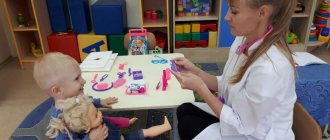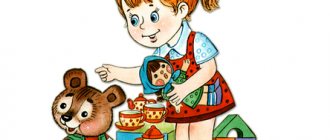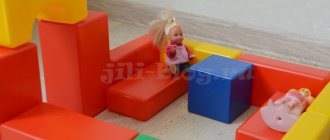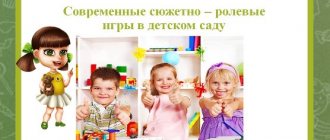Substitute toys for role-playing games for preschoolers. Consultation on the topic
Substitute toys for role-playing games for preschoolers
In preschool age, play becomes the leading activity, but not because the modern child, as a rule, spends most of his time in games that entertain him; play causes qualitative changes in the child’s psyche.
It is often said that a child plays when, for example, he manipulates an object or performs one or another action shown to him by an adult (especially when this action is performed not with a real object, but with a toy). But real play action will occur only when the child means another by one action, and another by one object.
A toy is found not only in a child’s play, but also in the everyday life of an adult. Often a toy is a friend, a life partner, a source of joy, a tool or material for play. The toy presents in a generalized form the typical properties of objects, including people and animals, which require appropriate actions with them. So, for example, a doll is a generalized image of a child that allows children to reproduce a whole range of appropriate actions: bathing, feeding, changing clothes, etc.
Toys are varied in type, material, manufacturing technique, age and educational purpose. The image in toys is conditional and generalized. The nature, degree of generality and convention depend on the type of toy and its specific purpose. Toys are divided into three groups according to the degree of complexity and generality:
- Realistic toys (a dog of a specific breed).
- Conventionally shaped toys (a dog of an unknown breed, a doll as a generalized image of a person).
- Substitute toys (a stick instead of a thermometer, a chair instead of a horse).
When analyzing the features of a preschooler’s play activity, it is necessary to remember that its development is facilitated by the development of the sign function of consciousness, which consists in the ability to use one object as a substitute for another. A prerequisite for mastering the sign function is the mastery of objective actions and the subsequent separation of the action from the object by the preschool child. Therefore, in addition to toys depicting real objects, the child must have objects that can be used as their substitutes: reels, boxes of various shapes, natural materials (cones, acorns, leaves). During the game, the child can give them a new game name and act in accordance with this name. Substitute items also include those that in practical pedagogy are usually called attributes: all kinds of hats, beads, robes, etc. The situation when a child turns a sofa into a steamboat, chairs into train cars, is also an indicator of the development of the sign function of consciousness, and therefore a high level of mental development.
For the development of children's thinking, imagination, speech and in order to raise play to a higher level, various substitute toys are of particular value. For example, when pretending to iron clothes, a child can take not only a toy iron, but also a brick made of building material. Substitute toys can be wooden and plastic circles, rings with a diameter of 3-5 cm, boards, strips of cardboard, substitute items, children’s favorite treats - candies, apples, etc. Together with the teacher, children can make substitute toys and attributes for games - cut out “pancakes”, “cutlets”, “fish”, “vinaigrette” from cardboard, foam plastic, using all this in games that imitate the labor process. By encouraging children to use gaming materials that replace objects that are well known to them, we create a situation in which the child will be faced with the need to designate substitute objects and actions with them in words, which will contribute to his active development.
The value of this toy is that for the first time children independently operate with conventional concepts. Play actions with a substitute toy are based not on visual signs of the object, but on imagined, assumed ones. Using such a toy, the child generalizes his previous gaming experience. A substitute toy requires more schematic generalized play actions and denoting it with a word so that it enters the context of the game and is understandable to others.
Replacement toys are made from a variety of materials. Dolls and animal toys can be made not only from fabric, but also from natural material (straw, wood, grass, etc.). Substitute items are needed from any natural material (chestnuts, pine cones, shells, straw, etc.) For games, you can prepare different sets of toys, united by a common plot. For example, for playing with a doll: doll, blanket, stroller, furniture (bed, table, chair); for playing with a dog toy: a feeding bowl, a sleeping mat, a leash for walking, etc.
For example, if a child is playing with a doll, then instead of it you can offer him a little chick wrapped in a blanket. Playing with such a “doll,” the child shows the missing, but represented by him, the main parts of the human body: the legs at the bottom of the toy, the head at the top. He plays with her as with an ordinary doll, and gradually the word increasingly begins to designate and replace objects that are missing but necessary for the game, their qualities, imaginary properties and states.
How to teach a child to play with such a toy? First, the adult names the substitute toy, and then the child. He calls it as required by the game's design.
The main requirement for a substitute toy is convenience in performing play actions and proportionality with other play material. If conventionally figurative and realistic toys can be bought, then the introduction of substitute toys into children’s play depends on the adult’s imagination, on his penetration into the content of the child’s game. Children watch with great curiosity how an adult, having understood their game plan, creates an object needed for the game from natural material. It is important that the substitute toy resembles the depicted object with general contours or some typical property, a characteristic detail necessary to display game situations (“The kitten” can be made of soft terry cloth, if it is rolled up and tied with a bow “around the neck”; instead bowls for feeding a kitten, you can offer a circle of cardboard, a plastic lid, etc.).
Often children not only enthusiastically use substitute toys offered by adults, but they themselves choose and agree in advance what they will mean: “This is a cat,” “This is a bowl,” “This will be the mother - a big cat, and this is her kitten.” While playing with such toys, the child tries to explain to other children what the substitute object means: “It’s a cat, touch it, it’s so fluffy, you can’t see the eye, it’s probably sleeping.”
Game substitutes for objects may have significantly less similarity with them than, for example, the similarity of a drawing with the depicted reality. However, game substitutes should allow you to act with them in the same way as with the replaced item. Therefore, by giving his name to the chosen substitute object and attributing certain properties to it, the child also takes into account some of the features of the substitute object itself. When choosing substitute objects, the preschooler proceeds from the real relationships of the objects. He readily agrees, for example, that half a match will be a bear, a whole match will be a mother bear, a box will be a bed for a bear. But he will never accept this option, where the teddy bear is a box, and the bed is a match. “It doesn’t happen like that,” is the child’s usual reaction.
So, communication between an adult and a child should be aimed at developing progressive ways of solving game problems for each age period. Children's activities should take place in increasingly complex game problem situations based on practical and play experience. Children who have mastered how to solve the first game problems should complicate the task. For example, not just give the doll tea, but sit it down at the table, prepare lunch first, etc. As children master game problems that are solved visually and effectively (an indicator of which is children's independent play), it is necessary to demonstrate new, more generalized ways of solving them with the help of substitute toys. For example, instead of a plate, offer a doll who really wants to eat a leaf from a tree. Later, children should be shown new ways to solve game problems using drawn objects (an adult takes the soap shown in the picture for bathing, etc.) And finally, it is necessary to show game actions with an imaginary object (give the doll an imaginary apple).
Familiarization with the environment and educational games create the basis for the emergence of play, but children’s independent play is determined by the appropriate organization of the subject-play environment and the activating communication between the adult and the child during the play. Timely changes in the play environment, selection of toys and play material that activates recent impressions in the child’s memory, direct the child to independently and actively solve a play problem, encourage different ways of implementing it and reproducing reality. The object-game environment changes taking into account the practical and play experience of children. It is important to promptly expand not only the range of toys with different themes, but also to promptly supplement the gaming material. An independent story game is formed more successfully if toys are introduced into it gradually (a conventional toy, a more realistic one, a substitute toy). The ability to use substitute objects in play activities is a necessary element in the development of children's play. It is very important to have a “Build It Yourself” construction corner in the group room, which includes sets of various building materials, a Lego-type constructor, a set of cubes; a corner of theatrical activities, where there are masks, bi-ba-bo toys, various costumes for role-playing games; various waste materials: boxes of different shapes and sizes, natural materials, a set of various rags, threads, spools, etc. For example, you can make a table, chairs, a sofa for dolls from cubes and building material, you can make a house and much more. Counting sticks turn into spoons, ladles, pistols and even pasta. Bricks serve as phones, pieces of bread, cakes, and cones turn into delicious ice cream. Beds are made from pieces of fabric, and food is made from cardboard and foam rubber for dolls.
Thus, substitute toys develop the child’s imagination, thinking, speech, and contribute to the development of relationships with peers. The possibility of using substitute items in play activities should be the subject of special discussion between the teacher and parents, since the latter often strive to buy as many ready-made toys as possible, not suspecting that they thereby harm the mental development of the child, in particular his imagination. But all subsequent schooling will be associated with the need to imagine, imagine, and operate with abstract images and concepts. This is, firstly. And secondly, the ability to use various objects (signs) instead of real objects will allow the child to subsequently learn more complex systems of signs, such as language, mathematical symbolism, and various types of art.
TYPES OF TOYS.
- Thematic or figurative toys (dolls, animal figurines, household items).
- Toys - tools (scoop, spatula, net).
- Technical toys with program or non-program control (transport units, machines).
- Game construction sets - prefabricated.
- Didactic toys and games.
- Toys for sports and outdoor games (balls, jump ropes).
- Theatrical and decorative toys (puppet theater characters, costumes, decorations).
- Fun toys.
- Sounding musical toys.
- Game materials and homemade toys.
- Play equipment (houses, layouts).
- Computer toys and games.
- Educational toys (puzzle games).
During games organized by adults, a two- to three-year-old child:
- gets acquainted with the subject environment,
- recognizes their names (toys, dishes, clothes, shoes, furniture, vehicles),
- learns to name the color, size of objects, the material from which they are made (paper, wood, fabric, plastic),
- compares familiar objects (different mittens, scarves, shoes),
- selects objects by identity (“Find the same one, pick a pair”),
- groups them according to the method of use (they eat from a plate, drink from a cup).
The child deepens his understanding of the phenomena of social life: family, kindergarten, hometown (town, village), the work of adults. The child develops basic ecological concepts and develops a caring attitude toward animals and birds.
Dear parents, teachers! Do you want your child to be intellectually developed, cheerful, healthy and inquisitive, move easily, love music and literature? This is very easy to achieve - play with your children! By presenting our original games to your attention, we hope that they will help you enjoy communication with your child, as well as the process of transforming your baby into a harmoniously developed personality [2].
The games listed below in kindergarten are designed for activities in kindergarten with children 2 - 2.5 years old. The games are also suitable for homeschooling.
Games in kindergarten: WATER, WATER, WASH MY FACE
Such games in kindergarten teach children to imitate the actions of an adult and develop hygiene skills. To play you need: soap, towel
Progress of the game. Wash yourself in front of your child - this will make him want to imitate you. Don’t forget to adjust the water for washing your hands and face, and explain to your child exactly how to wash. You can first wash the doll, showing it the algorithm of action. If the child finds it difficult, take his hands in yours and help. You can use soap to put a dot on the baby’s cheek or draw a line on the forehead and offer to wash it off yourself. Invite your child to wash the doll, then wash himself. Rejoice when you see your baby washed, praise him. When washing your child, you can say:
Water, water, Wash my face, So that my eyes shine, So that my cheeks glow, So that my mouth laughs, So that my teeth bite.
Water off a goose, Water off a swan, All the thinness off my child - To the empty forest, To the big water, Under a rotten log!
A woman was walking from overseas, carrying a cart of health. For this and that - little by little, and for Vanyushka - the whole box.
Games in kindergarten: THE DOG RUNS TO YOU
Such games in kindergarten develop the child’s speech. To play you need: wind-up toys: car, dog, chicken, cat, etc.
Progress of the game. Sit with your baby on the floor. Stretch your legs, spreading them, ask the baby sitting opposite to do the same. Your feet should touch, forming an enclosed space. Get the toy and point it towards the baby, commenting on what is happening, for example:
- The dog is running towards you,
- The car is coming to you,
- Oh, how the chicken fell.
If your child can start the car himself and direct it towards you, let him do it. If he needs your help, get a toy, but let the child direct it.
Games in kindergarten: SMILING FACE
Such games in kindergarten help the child learn to understand people's emotions. To play you need: books and magazines with illustrations.
Progress of the game. While looking through illustrations with your child, study people's faces. Ask your child what this or that face expresses. Find a picture of a smiling child. Describe to your child the emotions reflected on this child's face, and then ask him to show his smiling face. The next day, focus on other emotions: excitement, sadness, surprise. Look for faces that express the feelings your child is experiencing at the moment.
Games in kindergarten: HEDGEHOG AND HARE
Such games in kindergarten develop phonemic hearing and teach children to move to a certain rhythm. To play you need: pictures with images of a crawling hedgehog and a galloping hare, a tambourine.
Progress of the game. Show your child a picture of a hedgehog and explain that it moves slowly - the way a tambourine sounds now. The baby imitates the gait of a hedgehog to the slow beat of a tambourine. Then show a picture of a hare and say that he is jumping fast, and quickly knock on the tambourine. The child will jump like a hare. As the knock changes, the child moves accordingly.
Games in kindergarten: LEARNING TO HANG OBJECTS
Such games in kindergarten develop fine motor skills of the fingers. To play you need: items that the child can hang on a hook, such as a jacket, oven mitts, kitchen towels, bags.
Progress of the game. Give your child opportunities to practice hanging different objects. The hanger on your baby's jacket can be enlarged and made stronger. The hook or children's hanger should be secured at a convenient distance from the floor for the child. The hook must be highlighted: let it be a beautiful hard hook, for example, in the shape of someone’s paw; you can glue a bright picture or place a toy next to it. At first, help your baby hang up his jacket, guide his arms and correct his movements. The child must see the sequence of actions: he came from a walk, hung up his jacket.
Games in kindergarten: POURING WATER
Such games in kindergarten develop fine motor skills of the fingers. To play you need: a small jug of water, a glass (you can use doll dishes), a sink.
Progress of the game. Show your child a jug of water, teach him to pick up the jug, tilt it so that the liquid pours into the glass, then let him practice at the sink. Invite your child to pour water into a glass from a half-filled jug. The water can be warm or cold, tinted - the main thing is that the baby is interested in the game. When your child gets comfortable with pouring liquid, ask him to help you water your indoor flowers or pour water into a bowl for your cat or dog.
Games in kindergarten: EDITABLE - INEDIBLE
Such games in kindergarten form ideas about edible and inedible objects. To play you need: toys or pictures depicting edible and inedible objects.
Progress of the game. Place two objects in front of the baby, one of which is inedible, and ask: “What can you eat?” Next, you show the pictures, asking the child to make a choice. If you see that your baby has put something in his mouth, ask him to take the object out and explain why he should not put foreign objects in his mouth. If your baby doesn't put anything in his mouth while playing, praise him for it.
Games in kindergarten: PUT ON TIGHTS
Such games in kindergarten contribute to the development of actions related to dressing. To play you need: children's tights, a doll with tights.
Progress of the game. Take children's tights and first show your baby how to pull the tights on each leg in turn. Help your baby by using his hands. When the tights are on your legs, pull them up (to do this, your baby needs to stand up). You can gradually teach your child to “pick up” tights in his hand. If your baby copes with at least part of this task, you definitely need to praise him. Next, you can give the child a doll and ask him to put tights on the doll.






